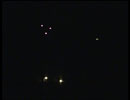TARANIS - A New UK Unmanned Combat Air
Vehicle WAS
Being
Flown Over Conisholme,
Out
of
RAF
Coningsby, Lincolnshire, 04/01/2009.[Model on
Display at
Farnborough Airshow.]
RAF
Coninsby has
been
used extensively
for testing
UAV's in the past,
and BEAMS has every
reason to
believe
that this is where
the Taranis is
currently
based.
Wikipedia Info on
the
Taranis
BAE Systems said "Taranis will make use of at least 10
years of
research and development
into low observables,
systems
integration, control
infrastructure and full autonomy. It
follows the completion of risk reduction
activities to
ensure the mix of
technologies, materials and systems used are
robust enough
for the 'next logical
step'."
These "risk reduction activities" were related BAE programmes including Replica, Nightjar I, Nightjar II, Kestrel, Corax, Raven and HERTI. BAE Systems Australia will have a workshare of about 5% in the programme. The Taranis demonstrator will have an MTOW of about 8,000 kilograms and be of a similar size to the BAE Hawk. The first steel was cut in September 2007 and assembly began in February 2008 .
Ground testing will start in early 2009 and the first flight of the Taranis is planned for the first quarter of 2010.
On the
9th
of
Janurary 2009 the MoD denied
the Taranis had been
flying near the
site of a
smashed
wind turbine,
after
local people claimed to have
seen a
UFO.
[Artist's Impression.]
-------------------------------
AGM
REPORT
NOTES
TARANIS is a £124m BAE
Systems, unmanned
combat aerial vehicle
demonstrator aimed
at helping the UK MOD
determine
the
future balance of
assets
within
the Armed Forces.
Named
after the Celtic God of
Thunder,
Taranis will
help inform
the UK
MODís approach to the future
capabilities needed for deep
target attack and
intelligence, surveillance, target
acquisition and
reconnaissance
(ISTAR).
About the
size
of
a BAE Systems
Hawk,
it has
low
observable
features
and
autonomous systems
which
allow it to think for
itself for much of its
mission.
Ground testing of
Taranis
is scheduled to begin
in
early 2009, with the first flight
trials
due
to
take
place
in
2010.
The
programme brings
together
a number of
technologies,
capabilities and
systems to
produce
a UCAV technology demonstrator based
around a
fully autonomous
intelligent
system. The Ďfirst
metal cutí
on the
new
airframe
took
place at BAE
Systemsí
manufacturing
facility in
Samlesbury, Lancashire
this month.
Taranis
is
part of
the
UK
Governmentís
Strategic
Unmanned
Air Vehicle
(Experiment), or
SUAV
(E). The UK
MODís
team
leader
for
the
programme, Jonathan
Barrett,
joined
the
managing
director of
Autonomous Systems
and
Future
Capability for BAE
Systems,
Mark Kane in the
Lancashire
facility to
commission
the
start of
the
machining
process. He
said: "This
programme
is not just about
positioning UK
industry and
putting the
UK on the
map with
cutting
edge
technology; it
is also about
informing
the basis of
the
potential
future Royal Air
Force and our future
potential
capability."
BAE
Systems
is
the industry lead on the
Taranis
technology demonstration
programme working together with Rolls-Royce,
QinetiQ
and
the Systems
division of GE
Aviation (formerly Smiths Aerospace) as
well as a
range of
UK-based
suppliers. Mark
Kane said: "We have a
big team
around us and
we are going to
do
this together.
Taranis is one
of the most
important
defence
projects
currently underway
and will
help maintain UK capability
over the
next
20 years. It
makes use
of at least
10 years of research
into low
observables,
systems
integration,
control
infrastructure
and full autonomy. It
builds on a
number
of
successes with risk
reduction
programmes and it
harnesses a range
of
new
skills
acquired around rapid
engineering.

